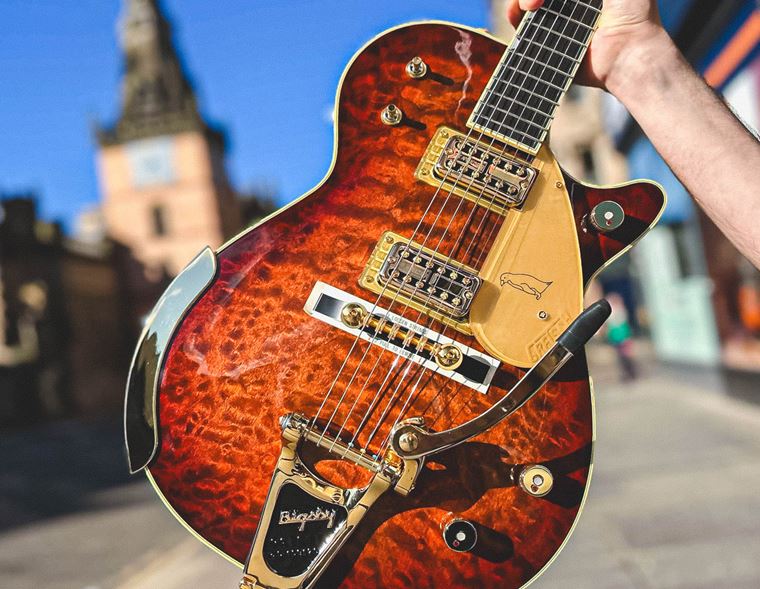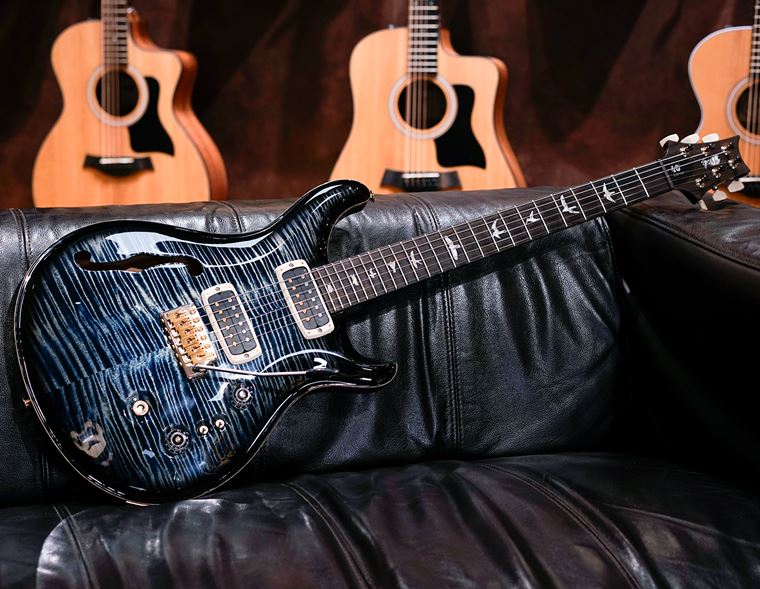Our Expert Guide to Acoustic Guitar Body Shapes
Published on 21 January 2021
Acoustic guitars are as simple and as direct as it gets when it comes to instruments. Just a wooden box, a neck and a set of strings. You pick it up, form some chords and get playing. There are no cables, no pedals, no batteries... just you and your notes. Brilliant. Simple and perfect.
But it’s not quite that simple, is it? Even setting aside the notion of electro acoustics with built-in preamps, and without even getting into the subject of tone woods, we still have to consider the notion of the acoustic guitar’s body shape. There are a great many out there, and this can sometimes cause confusion to guitarists both beginner & advanced.
Why do these various sizes exist? What’s the difference and how do you know what’s right for you?
Today’s blog article will hopefully shed some light on these questions and inform you about the range of acoustic guitar bodies that are out there in the world. We’ve picked the most popular shapes, given examples of guitars that adopt those shapes, and explained a little of their application.
One thing to remember, though: you can really play any style of music on any style of acoustic guitar. When we later say that a Jumbo is designed for rhythmic strumming, it doesn’t mean for a second that you can’t perform delicate fingerpicking pieces on one. Not at all! There are just certain styles that are a little better suited to certain shapes, that’s all.
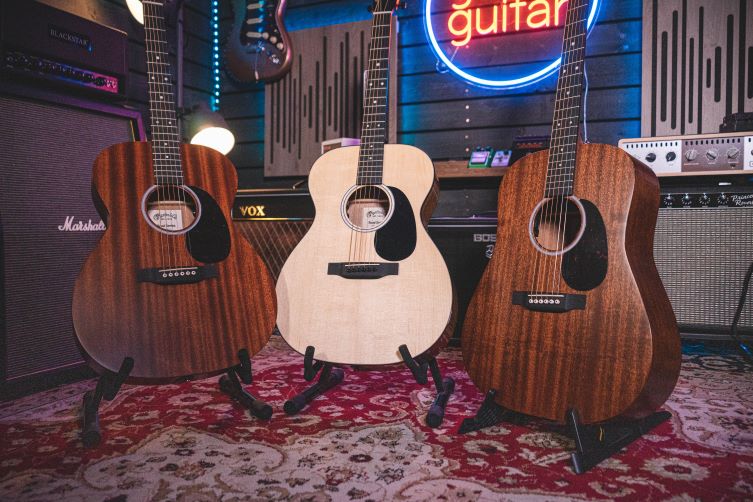
Contents
- Acoustic Guitar Body Shapes Explained
- Classical Guitars
- Parlour Guitars (also ‘0’)
- Dreadnought Guitars
- 00 Guitars
- OM/000 Guitars
- Jumbo Guitars
- Modern Cutaway Guitars
- Travel Guitars
- Many Sizes Fit All
Acoustic Guitar Body Shapes Explained
1. Classical Guitars
Classical guitars are perhaps the most resolutely traditional of all styles. This is the source form which all other styles emerged, adapted and developed.
The classical guitar, as we know it, with its symmetrical non-cutaway body and slot-headed wide neck, is from the Mediterranean area and is over two hundred years old. Prior to this, guitar-like instruments were to be found around the Balkans, the Greek Islands and the Iberian Peninsula for many centuries. This implies a Byzantine or indeed Persian origin, but it’s a little hard to be precise these days.
Classical guitars have nylon strings, no truss rod (a metal strengthening rod up the middle of the neck) and tend to be lean on the decorations, save for rosettes around the sound holes. The necks join the bodies around the 12ft fret, and they tend to produce a soft yet relatively loud sound.
Flamenco guitars are largely similar but sometimes use thinner soundboards (the top of the instrument) and have the strings closer to the frets for that characteristic flamenco ‘twang’.
What’s pretty amazing is how relatively unchanged the classical guitar remains. Examples exist in museums from centuries ago, looking just as new models do today. If it works, it works!
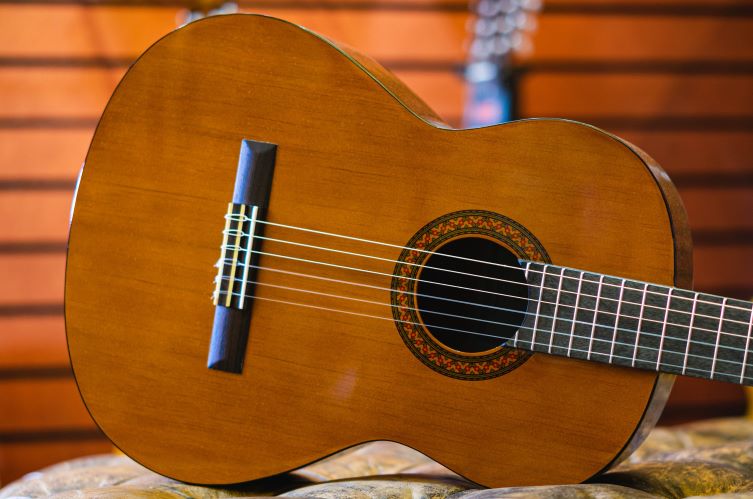
2. Parlour Guitars (also ‘0’)
Parlour guitars are small-bodied steel string acoustic guitars. They were initially popular in the ‘Pre-War, Pre-Depression’ days, so we’re talking the late 19th and early 20th centuries. Music in general was quieter (no amps, no ‘drum kits’ to speak of), and people wishing to play at home could do so with small, portable, more comfortable instruments. These made less noise so players would often play them on their front porches or backrooms, hence the title.
Parlour guitars have come back into the fore in recent years, as the guitar market experiences a general trend for smaller acoustic instruments. Despite having more compact bodies, most parlour guitars are still ‘full-sized’: that is, the neck is usually 4/4 and has a full width and profile. It’s just the smaller body that makes them a little quieter and slinkier. Martin refer to their parlour size as ‘0’ and often use a slotted headstock in order to retain more of that Pre-War authenticity.
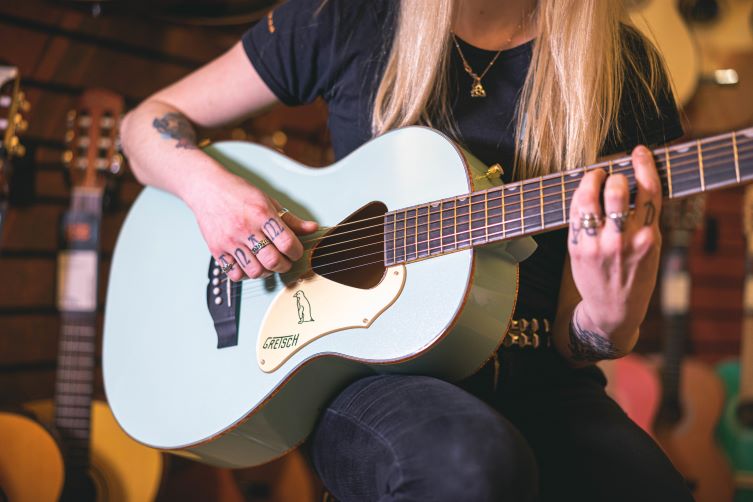
3. Dreadnought Guitars
Without question, the dreadnought shape is the one most of us associate with the notion of the ‘acoustic guitar’. Made in far larger quantities than any other style, the dreadnought is often the fledgling players’ first hands-on experience of an acoustic.
The dreadnought shape was first developed by Martin & Co, one of the most famous historical American guitar brands. The shape, which can be described as relatively ‘boxy’ and with ‘wide hips’ was created by Martin in order to provide more volume and presence to turn-of-the-century guitarists who were tired of being drowned out in ensemble musical situations. Cellos and brass were so much louder than typical guitars of the day - such as the parlour guitars we just looked at - that guitars were quickly becoming lost in a group musical setting. The larger body of the dreadnought helped move more sound, and resonated over a larger surface area, helping to provide volume and projection.
As for the name, ‘dreadnought’ is indeed taken from the type of military warship, in reference to it being the biggest type of ship on the water. At the time, these were the biggest guitars!
Guitars would soon get even bigger, as we’ll see, but the dreadnought is, for many, the optimal size for an acoustic guitar. It offers strong percussive qualities for strummers, and still sounds sweet when played in a fingerstyle fashion. It has become known as a successful jack of all trades, as Country, Folk and (later on) Rock players all gravitated to its agreeable mix of properties.
Also, the dreadnought is one of the most visible guitar designs on Earth, given how many well-known and influential players use or have used them. Listing names would be somewhat pointless, since the list would include almost every famous guitarist and singer/songwriter ever!
The most famous Dreadnought – or should we say the most copied? – is undoubtedly the Martin D-28. The model defines the shape that everyone else has since taken, and indeed the sound. The D-28’s use of Spruce and Rosewood marks a combination that has endured since its creation, and has set the standard for loud and clear dreadnought tone. It’s a sound that in many ways is the acoustic guitar, and that looks set to continue well into the future.
Another notable dreadnought is the Gibson Hummingbird, a characteristically ornate dreadnought guitar with eye-catching appointments like custom inlays and a decorative pickguard. Both this and the D-28 are perhaps good indicators of how Martin and Gibson approach the art of acoustic guitar building: entirely differently and yet equally classic.
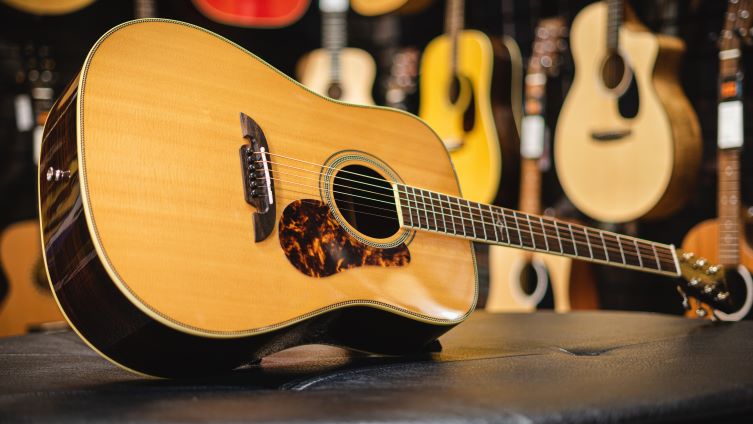
4. 00 Guitars
This shape has become extremely popular in recent years, particularly with fingerstyle players. This is partly to do with the smaller body size (it sits in between a parlour and a dreadnought in dimensions) and partly to do with its tight bass response and sweet top end. Folky fingerstyle parts really thrive on 00-style guitars. This style is a little smaller than 000 guitars, which we’ll see next, and enjoys that tighter tone due to a somewhat thinner body depth. It’s amazing to note how the small differences add up!
5. OM/000 Guitars
The OM or 000 is normally around one inch longer and wider in dimension than the 00, but otherwise uses the same outline. Also referred to as the ‘Orchestral model’, the OM is almost identical to the 000 style guitar, with only one significant difference: the scale length. The 000 has a 24.9” scale length, while the OM typically uses a slightly longer 25.5” scale. Acoustic blues players who enjoy making ¼ tone bends will therefore have an easier time of it on a ‘triple oh’!
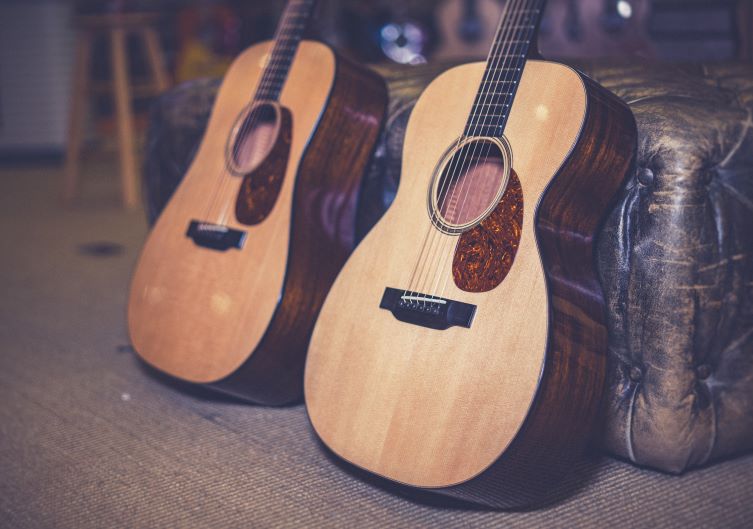
6. Jumbo Guitars
Jumbo guitars are all about volume. Big, bold and beautiful, a jumbo acoustic is the perfect match for singers who want to accompany themselves with some loud, percussive rhythms from a guitar that can be both seen and heard from the very back of the venue!
The was the idea, of course, in the days before PA systems existed. These days, people tend to enjoy the large projection and depth of sound for their own merits.
It’s probably fair to say that the most famous jumbo – thanks to Elvis, Bob Dylan and others – is the Gibson J-200. Much like the Hummingbird, this fabulous guitar matches ostentatious decoration with timeless class and lovely finishing.
The J-200 makes even more of a punch sonically than it does visually, thanks to its maple and spruce construction. Maple has strident and clear sound with lots of top end, kind of like spruce (but more so, if you follow us), and so those qualities, mixed with such a large body (therefore larger soundboard and large inner space for sound to resonate) means that the J-200 is one of the most ‘there’ acoustic guitar sounds ever! It’s a huge, confident sound that really fills up a room with sound and presence. There’s a lovely sparkle to the sound, on top of the massive low end, of course!
This formula is used by many other manufacturers for their jumbos. Like we saw with spruce & rosewood for the dreadnought, it’s just one of those ‘correct’ combinations.
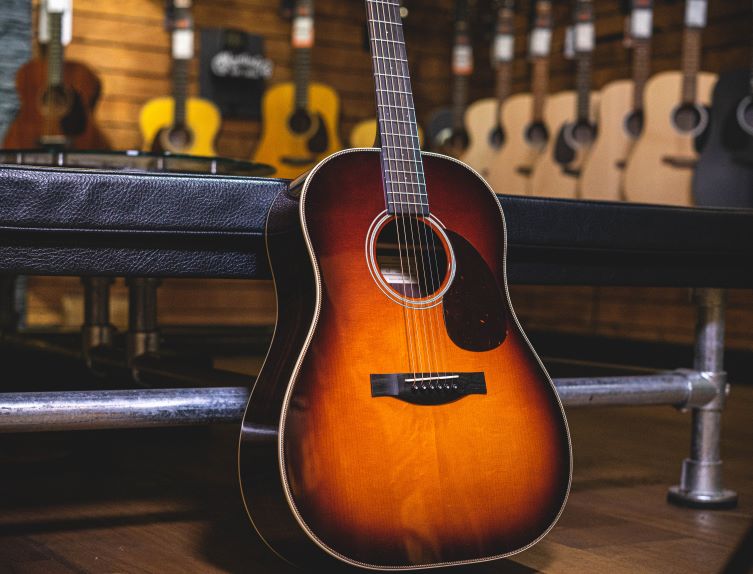
7. Modern Cutaway Guitars
These days, acoustic guitars appear in a great many varieties, and not all of them are based on classics from a century ago! Contemporary builders like Taylor and Takamine thrive with designs that are their own, or at least updated renderings based on principles from the past. Generally, although most companies offer a wide range of models, these modern guitar designs can often be described as slightly smaller than a dreadnought, with a slightly narrower waist, and often with a cutaway.
Made for performers, this type of guitar offers an excellent compromise between tone, playability and practicality. The slightly smaller bodies help protect against feedback (when played live, of course) and their slightly ‘OM’-style bodies work well with both fingerstyle and strummed techniques.
Cutaways are not new by any means, but their use in a design often denotes a guitar intended for live use (electro models often have the cutaway, whereas equivalent non-pickup versions lack the cutaway). Why? It’s hard to say really, since there doesn’t seem to be any correlation between live guitar playing and upper-fret access! We think it’s just become a tradition, and companies have all adopted it for some reason. It’s quite clear that a cutaway will be useful to some players and not others, regardless if they play to audiences or not. Still, it’s something we do see a lot of. Cutaways allow you to easily reach those higher frets, so if your technique demands it, you’ll be wise to opt for a cutaway model acoustic.
Taylor’s ‘14’ body style (see above pic) is also known as the ‘Grand Auditorium’, and Taylor themselves refer to this as their most versatile design. This is a prime example of the ‘modern cutaway’ guitar, with its somewhat smaller body and contemporary lines.
Takamine base many of their instantly recognisable modern guitar designs on what they term a ‘Grand Concert’ style. The style is something of a modern classic, and bears only a slight resemblance to the likes of a dreadnought or a 000.

8. Travel Guitars
In recent years, smaller bodied and shorter-scale acoustic guitars have become almost the most popular style available. The actual body shapes can vary to a fair degree, though all of them feature smaller scale lengths, ranging from 22.75” (Baby Taylor) and 23” (Little Martin LX1) to 23.5” (Taylor GS Mini). This factor means that such instruments have a distinctly different feel when compared to standard acoustic guitars. Players are seeming to love the extra comfort factor and intimacy involved in playing an instrument that is smaller and closer to their body. Happily, they still sound great!
Though known as ‘travel guitars’, it seems that most guitarists like having these around as handy ‘pick up and play’ guitars for the house. The small size and ease of play makes these guitars extremely ‘moreish’ and the fact that they take up less room seems to be a bonus too!
Many Sizes Fit All
Yes, it seems that there are more designs than ever, and each brings its own benefits. Deciding on shape, scale length and cutaways is all part of the fun!
Whilst acoustic guitars largely follow a very similar idea in terms of function, the details can differ quite a lot, as we’ve seen today. You may well get on fine with all varieties, but you’ll undoubtedly favour a certain style over others. That’s what makes guitars such wonderful instruments: they are so variable, and cater to everyone’s needs and preferences!
Indeed, there are even more styles out there that we’ve not touched upon today (for example, bowl back Ovation-style guitars were omitted since we hardly see them around these days...) but 99% of the acoustic instruments out there will adhere to the overall shape and function of the styles we’ve outlined today.
Who knows what the future will bring, though? Even though guitar players are a conservative bunch when it comes to embracing ‘modernity’ (we love the old classics!), we’re sure that some innovative acoustic designs will be right around the corner. We’ll be there to report on them and bring them to you, but until then, please do have a browse at the fantastic acoustic guitars we have in stock right now, in all shapes and price brackets!
The acoustic guitar: simple, direct, and diverse!







